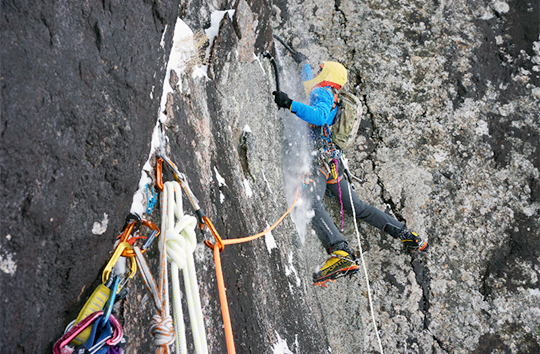
[Photo] Anna Pfaff
[This story was first published on willmayo.us on March 8, 2015.–Ed.]
On March 7, 2015, Anna Pfaff and I sent a giant, long-standing traditional mixed project on the Cholesterol Wall above Ten Mile Pond in Gros Morne National Park outside of Rocky Harbour, Newfoundland. Apocalypse Now (WI7 M9, 220m) was one of the few remaining king lines of the area that had yet to be climbed. The route stands looming over the east end of the pond on an imposing south-facing monolith dubbed the Cholesterol Wall. The left side of the wall is the site of Joe Terravecchia, Casey Shaw and Jim Shimberg’s testpieces Tundering Lard and Baby Beaver. Routes have been done to the right of the wall as well. The prominent lines in the center of the wall, however, had remained unclimbed.
For nearly two decades, New England alpinists Terravecchia, Shaw, Shimberg and Andy Tuthill have been exploring and developing the vast expanses of Gros Morne. Operating almost completely under the radar, these hard-core traditional activists have climbed nearly every prominent hard ice and traditional mixed line in the park, ticking off a mind-boggling list of radical, futuristic lines, all done in raw traditional style, completely without protection bolts or bolted belays. Preferring to render homage to the gifts of nature, these men have been rewarded with the pure satisfaction of sending the first ascents of many of the biggest and hardest traditional mixed climbs in North America. They also have paid a premium for the retention of risk, for the full engagement that is traditional mixed climbing.
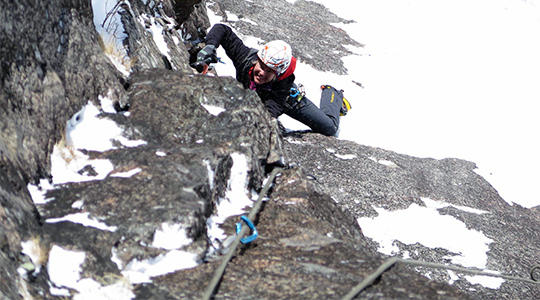
[Photo] Will Mayo
Our route, Apocalypse Now, was the site of two nearly fatal accidents involving Terravecchia. On the first occasion, in the early 2000s, Terravecchia, along with Shaw, was climbing the couloir directly below the icicle (later dubbed the Carry-Out Couloir) when the entire hanger spontaneously calved, pummeling the two men, who cowered helplessly in the funnel of the gully below with tons of ice, breaking Terravecchia’s shoulder and giving both a full-body battering. On the second occasion, in 2004, Terravecchia reached the crux -ice section with Tuthill. Leading the crux near the top, Terravecchia pulled up onto the dagger, just above where he reckoned the would-be fracture line was, when the entire 20-ton structure of ice collapsed, crashing down, pinning the rope between the two climbers as it fell, ripping Terravecchia downward and pulling the rope violently through Tuthill’s belay device, burning through his gloves and through the skin on the palms of his hands. The old Yankee Tuthill held on, and caught Terravecchia, now hanging unconscious 50 feet below the sheltered belay, having fallen 100 feet amid giant hunks of ice. Terravecchia woke to Tuthill yelling down at him in horror. The two managed to get themselves down, despite Terravecchia’s broken tibia and a body completely covered with bruises. This route meant business.
About a month ago, my planned trip to Norway with a collection of French hardmen was cancelled last-minute due to warm weather in Gudvangen. Frustrated, I pondered how best to spend my already allowed free-time. Pfaff, who I met at the Michigan Ice Fest, was keen to climb and also happened to have the next few weeks off from her work as a nurse. We went to the Canadian Rockies and tested our mettle on the Stanley Headwall for a few days, sending Nemesis and an unformed and extremely challenging version of French Reality. I was impressed by Pfaff’s abilities and her seemingly indefatigable motivation. We climbed well together, and I asked her if she was keen to go find some adventure in Newfoundland, the North American equivalent of Norway, which was still well within winter’s firm grasp. She agreed without hesitation, so I sent Terravecchia an email.
Having grown up in New England, my formative climbing was steeped in the staunch traditional ethic of that area. Terravecchia is one of my long-time mentors from early adulthood, and I had long heard rumors of the towering ice and mixed routes that Terravecchia and company established silently every winter. In part because of him, Newfoundland has assumed an almost mythical quality among ice and traditional mixed climbers. It’s a land awash with mystery and uncertainty, a land of adventure and full-value traditional winter climbing. I had always wanted to visit Newfoundland, and, finally, it seemed, I had found the opportunity. I asked Terravecchia if there were any hard-mixed lines that remained unclimbed. He sent me a picture of what would become our project, and told me the stories of his accidents, which I had already heard years ago, shortly after they had happened. Terravecchia said it would be a long time before he got back to it, having moved on to objectives farther north in the park, and we should give it a try.
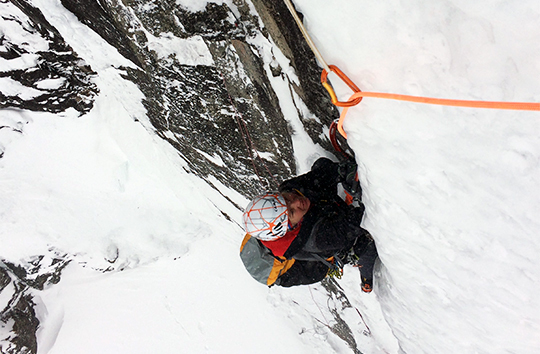
[Photo] Will Mayo
Pfaff and I packed up my little Mooney single-engine piston aircraft in Denver, Colo. and flew to Madison, Wis. on February 26. We continued on to Burlington, Vt. later that day and spent the night filing our flight manifest for the trans-border flight the next day. In the morning we flew to Sept-Iles, Quebec, cleared customs, fueled up and then continued on along the vast untracked expanses of the frozen north coast of the Bay of St. Lawrence, outside radio communication and radio navigation as well as radar coverage. We turned back south at Lourdes-de-Blanc-Sablon, crossed above the partly frozen Strait of Belle Isle, and flew down the west coast of Newfoundland to our destination: Deer Lake.
My old friend, Damien Cote, noticed a social media post of mine about our travels to Newfoundland, and he sent me a message, which I received immediately upon our arrival in Deer Lake. Cote told me to contact Pete Thurlow, a prolific local climber who happened to have a snowmobile. I called Thurlow and he told me he was planning to use his sled to climb himself over the next few days, but he put us in touch with the local snowmobile guide guru, Rick Endicott. Endicott, Thurlow and virtually every other Newfie we met, are extraordinarily helpful and accommodating, replying to every question and request with the simple utterance: “Not a problem!” When we realized the magnitude of our project, Thurlow graciously loaned us jumars and ropes while we were waiting for a shipment of 200 meters of static line from the Mountain Equipment Co-op. Without the help of our friends and locals, for whom we are eternally grateful, this route never would have happened for us.

[Photo] Anna Pfaff
On our fifth day of effort on the Cholesterol Wall, we sent Apocalypse Now to the summit after climbing and fixing the first five pitches over the previous four days. Honestly, it’s the wildest climbing I have ever done in my life. Pitch 1 (M8, 30m) is perfect dry-tooling crack climbing in a leaning corner with a smattering of welded smears of ice and two overhangs. I onsighted this pitch on our first day, after two false starts to the left. Pitch 2 (M8, 15 meters) is a short but spicy section to reach the ice. The gear was difficult to find and place, requiring me to aid the pitch to get the Peckers, tomahawks and knifeblades in place in the discontinuous seams. I redpointed this pitch on the third day on the route. Pitch 3 (WI4, 40m) is ice and a welcomed respite from the more demanding climbing below. Pitch 4 (WI7, 35m) is some of the most unstable and surreal ice climbing I have ever done. Basically, it involves climbing bizarre giant ice-blob formations interspersed with bare, compact granite and patches of parched two-inch-thick plates of ice. Pitch 5 (WI5, 20m) is a strange traversing pitch of completely unprotectable shell-ice covering a thin layer of hoar-snow over smooth, fissure-less brown granite. There is only one piece of gear on this pitch, half way across, and it is a #1 knifeblade in a seam. Pitch 6 (M9, 40 meters) is the money pitch. Words cannot describe the perfection of the traditional mixed climbing involved. Suffice to say, it’s the best pitch of my life and the gear is perfect in the corner. The transition to the ice is terrifying, but not too dangerous. Pitch 7 (WI6, 4m) is the icing on the cake.
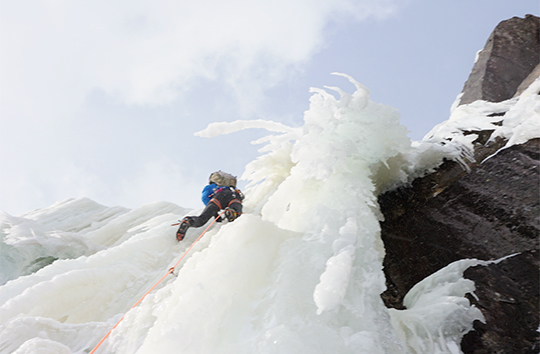
[Photo] Anna Pfaff
Newfoundland is famous for its strict traditional ethic. There are no bolts anywhere in Gros Morne National Park. As Terravecchia says, “I just want to make it clear that neither I nor Casey nor any of the guys I’ve climbed with up there pretend to have any kind of authority over whether bolts should or should not be placed on these type of routes in and around Gros Morne. We may feel strongly that they are not appropriate but ultimately, it’s not our decision to make but rather one for Newfoundland climbers. The few Newfoundland ice climbers that we have met and discussed the issue with have been very supportive of the idea.” Basically, it’s widely accepted that bolts are completely incongruous in Newfoundland and there is essentially “zero tolerance” for them among the locals. Newfoundland is an exceptionally adventurous and exciting climbing venue, like none other I have ever experienced, in a remote and savagely inhospitable place. And, we would like it to stay that way.
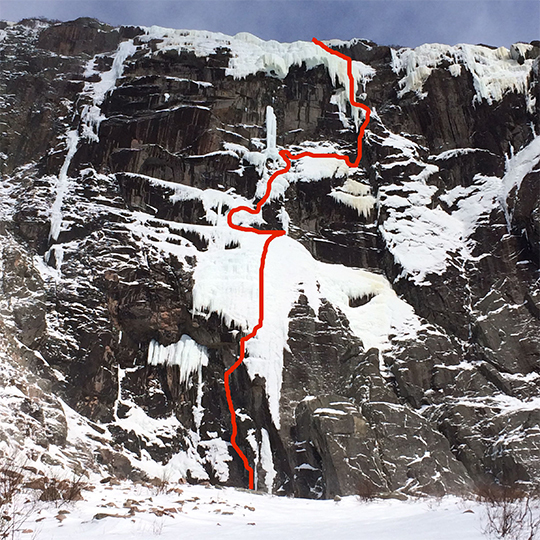
[Photo] Will Mayo